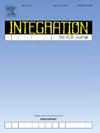FPGA implementation of EEG based hardware optimized data encryption technique for IoT applications
IF 2.2
3区 工程技术
Q3 COMPUTER SCIENCE, HARDWARE & ARCHITECTURE
引用次数: 0
Abstract
This paper has presented a new electroencephalogram (EEG)-based encryption technique for enhancing image data security using an FPGA implementation for IoT applications. The technique has used EEG datasets to create 64-bit keys, which have undergone testing using the NIST SP 800-22 test suite for randomness check. The generated keys have been combined with the image data and subjected to substitution and LFSR-based permutation in a proposed order. The proposed method has implemented the RTL design on a Virtex-7 FPGA device, with careful selection of rounds to optimize encryption process efficiency. The hardware expenditure per round on the FPGA device has been assessed to determine the optimal limit on the number of rounds, and the simulation results have been validated using MATLAB. The parameters Number of Changing Pixel Rate (NPCR) and Unified Averaged Changed Intensity (UACI) have been calculated as 99.5697% and 33.4776%, respectively, while the entropy of the encrypted image is 7.95, indicating that the suggested approach exhibits greater resilience against differential attacks. The proposed method has achieved a maximum operating frequency of 815.395 MHz and efficiency of 5.623 Mbps/slice on Virtex-7 FPGA device which has exhibited a 49.95% increase in the maximum frequency of operation and a 7.11% gain in efficiency when compared with the state of the art. These improvements have been important for reducing the encryption time and efficiently utilizing the hardware with the optimum number of slices.
基于EEG硬件优化的物联网数据加密技术的FPGA实现
本文提出了一种新的基于脑电图(EEG)的加密技术,用于增强物联网应用的FPGA实现图像数据安全性。该技术使用EEG数据集创建64位密钥,并使用NIST SP 800-22测试套件进行随机性检查。生成的密钥已与图像数据结合,并按照建议的顺序进行替换和基于lfsr的排列。该方法在Virtex-7 FPGA器件上实现了RTL设计,并精心选择了轮数以优化加密过程效率。评估了FPGA器件每轮硬件开销,确定了最优的轮数限制,并利用MATLAB对仿真结果进行了验证。计算得到的NPCR和UACI参数分别为99.5697%和33.4776%,而加密图像的熵值为7.95,表明该方法对差分攻击具有更强的弹性。该方法在Virtex-7 FPGA器件上实现了815.395 MHz的最大工作频率和5.623 Mbps/slice的效率,与现有技术相比,最大工作频率提高了49.95%,效率提高了7.11%。这些改进对于减少加密时间和有效利用具有最佳切片数量的硬件非常重要。
本文章由计算机程序翻译,如有差异,请以英文原文为准。
求助全文
约1分钟内获得全文
求助全文
来源期刊

Integration-The Vlsi Journal
工程技术-工程:电子与电气
CiteScore
3.80
自引率
5.30%
发文量
107
审稿时长
6 months
期刊介绍:
Integration''s aim is to cover every aspect of the VLSI area, with an emphasis on cross-fertilization between various fields of science, and the design, verification, test and applications of integrated circuits and systems, as well as closely related topics in process and device technologies. Individual issues will feature peer-reviewed tutorials and articles as well as reviews of recent publications. The intended coverage of the journal can be assessed by examining the following (non-exclusive) list of topics:
Specification methods and languages; Analog/Digital Integrated Circuits and Systems; VLSI architectures; Algorithms, methods and tools for modeling, simulation, synthesis and verification of integrated circuits and systems of any complexity; Embedded systems; High-level synthesis for VLSI systems; Logic synthesis and finite automata; Testing, design-for-test and test generation algorithms; Physical design; Formal verification; Algorithms implemented in VLSI systems; Systems engineering; Heterogeneous systems.
 求助内容:
求助内容: 应助结果提醒方式:
应助结果提醒方式:


